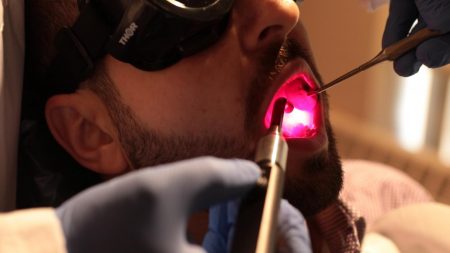Source: www.photonics.com
Author: staff
University at Buffalo (UB) researchers have received part of a $1.5 million grant to investigate light therapy as a replacement for prescription opioids in treating oral mucositis, painful ulcers, and swelling in the mouth that result from chemotherapy and radiation treatment for cancer.
Funded by the National Institutes of Dental and Craniofacial Research Small Business Innovation Research program, the grant will help the researchers determine the effectiveness of photobiomodulation in prevention and treatment of oral mucositis after cancer treatment.

At a high power, light, often in the form of a laser, is used in medicine to cut or destroy tissue. But at a low level, it has the ability to relieve pain and promote healing. Courtesy of Douglas Levere, University at Buffalo
The grant was awarded to Cleveland-based MuReva Phototherapy, a spin-off company of lighting solutions manufacturer Lumitex, to further develop the light technology. UB received $511,000 of the award to test the technology.
The research, led by Praveen Arany, DDS, assistant professor in the UB School of Dental Medicine, will be performed in collaboration with faculty from the Departments of Radiation Medicine and Oral Oncology at Roswell Park Comprehensive Cancer Center.
“The current epidemic of opioids has impacted cancer care, especially for cancer pain relief,” Arany said. “This treatment offers a simple, nondrug, noninvasive treatment approach to relieve pain and improve quality of life for cancer patients. The striking lab and clinical evidence for photobiomodulation treatments in supportive cancer care has demonstrated tremendous promise.”
Arany, who is president of the World Association for Photobiomodulation Therapy and co-chair of the committee on light therapy for supportive oncology care of the Multinational Association of Supportive Care in Cancer, is an advocate for wider use of photobiomodulation in the United States. He recently took part in the first congressional briefing on photobiomodulation before the House Science, Space, and Technology Committee in Washington, D.C. The briefing, held Oct. 11, 2018, invited a panel of international experts on the therapy to discuss the potential of photobiomodulation to improve health care and lower dependence on opioids.
“The ability of low-dose light therapy to promote healing has been established since the 1960s,” Arany said. “A major obstacle with its widespread use has been a lack of understanding of its precise biological mechanism. Recent work from our group has outlined both therapeutic and dose-limiting molecular pathways that are aiding development of safe and efficacious clinical protocols.”

Leave A Comment
You must be logged in to post a comment.